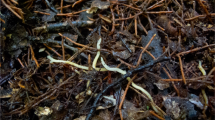Abstract
THE heartwood of teak (Tectona grandis L.f.) is extremely resistant to attack by insects or by fungi; but the reasons for this resistance are not known. It is usually ascribed to the presence of toxic substances, and it has been suggested that tectoquinone (β-methyl anthraquinone), which is characteristically present in teak heartwood, may be responsible. Wolcott1 has shown this substance to be highly repellent to the dry-wood termite Cryptotermes brevis (Walker), and Sandermann and Dietrichs2 have demonstrated its toxicity, in high concentrations, to the North American subterranean termite Reticulitermes flavipes Kol. No reference seems to have been made to its toxicity to fungi. In current investigations into the chemical basis of the durability of teak, we have examined the amount of tectoquinone in teak from Thailand and Indonesia, and its toxicity to decay fungi and to subterranean termites.
This is a preview of subscription content, access via your institution
Access options
Subscribe to this journal
Receive 51 print issues and online access
$199.00 per year
only $3.90 per issue
Buy this article
- Purchase on Springer Link
- Instant access to full article PDF
Prices may be subject to local taxes which are calculated during checkout
Similar content being viewed by others
References
Wolcott, G. N., J. Agric. Univ. Puerto Rico, 39, 115 (1955).
Sandermann, W., and Dietrichs, H. H., Holz als Roh-und Werkstoff, 15, 281 (1957).
Fewster, M. E., and Hall, D. A., Nature, 168, 78 (1951).
Kafuku, K., and Sebe, K., Bull. Chem. Soc. Japan, 7, 114 (1932).
Da Costa, E. W. B., Aplin, T. E. H., and Tamblyn, N., “The Comparative Resistance to Decay of Eight Australian Timbers under Different Conditions of Testing”, Division of Forest Products, C.S.I.R.O., Melbourne. Project P.13-5, Prog. Rep. No. 1 (Nov., 1957).
Gay, F. J., Greaves, T., Holdaway, F. G., and Wetherly, A. H., “Standard Laboratory Colonies of Termites for Evaluating the Resistance of Timber Preservatives and Other Materials to Termite Attack”, Bull. No. 277 (C.S.I.R.O., Melbourne, 1955).
Da Costa, E. W. B., and Rudman, P., Aust. J. Biol. Sci. (in the press).
Author information
Authors and Affiliations
Rights and permissions
About this article
Cite this article
RUDMAN, P., DA COSTA, E., GAY, F. et al. Relationship of Tectoquinone to Durability in Tectona grandis . Nature 181, 721–722 (1958). https://doi.org/10.1038/181721b0
Published:
Issue Date:
DOI: https://doi.org/10.1038/181721b0
This article is cited by
-
Contrasting the distribution of butterflies and termites in plantations and tropical forests
Biodiversity and Conservation (2017)
-
A review of heartwood properties of Tectona grandis trees from fast-growth plantations
Wood Science and Technology (2014)
-
Color and chemical characterization of partially black-streaked heart-wood in teak (Tectona grandis)
Journal of Forestry Research (2009)
-
Über die Wirksamkeit einiger organischer Verbindungen gegen die BodentermiteReticulitermes flavipes (Kollar)
Holz als Roh- und Werkstoff (1973)
-
Zum Resistenzverhalten von Holz bei natürlicher Bewitterung
Holz als Roh- und Werkstoff (1969)
Comments
By submitting a comment you agree to abide by our Terms and Community Guidelines. If you find something abusive or that does not comply with our terms or guidelines please flag it as inappropriate.



